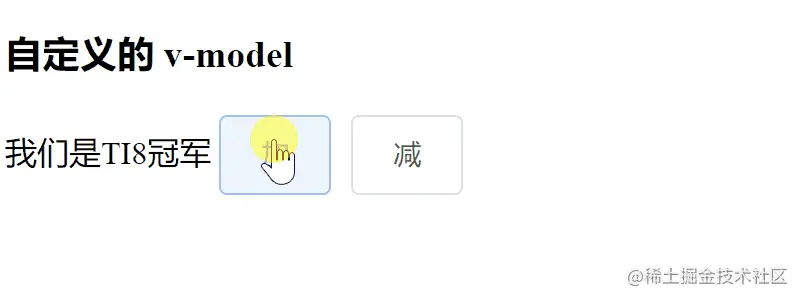 Web Front-end
Web Front-end
 Vue.js
Vue.js
 Take you to have an in-depth understanding of v-model in vue2 and see how to make components support this syntax
Take you to have an in-depth understanding of v-model in vue2 and see how to make components support this syntax
Take you to have an in-depth understanding of v-model in vue2 and see how to make components support this syntax
This article will take you to understand v-model in vue2, see whether v-model is two-way binding or one-way data flow, and how to make the components you develop support v-model. I hope it will be helpful to everyone.

Read this article
You will:
- Understand: What is
v-modelSyntactic sugar?vue2What special processing has been done to native components? - Find out:
v-modelIs it one-way data flow or two-way data binding? - Figure out:
v-modelWhat are the "side effects" beyond syntactic sugar? - Learn how to make your components support
v-modelsyntax.
1. The essence of v-model is syntactic sugar.
『
v-modelis essentially just syntactic sugar. It is responsible for listening to user input events to update data and perform some special processing for some extreme scenarios. 』 --Official documentation. [Related recommendations: vue.js tutorial]
What is syntactic sugar?
Syntax sugar, simply put, is "convenient writing".
In most cases, v-model="foo" is equivalent to :value="foo" plus @input ="foo = $event";
<!-- 在大部分情况下,以下两种写法是等价的 --> <el-input v-model="foo" /> <el-input :value="foo" @input="foo = $event" />
Yes, in most cases this is true.
But there are exceptions:
vue2provides themodelattribute to the component, allowing users to customize The prop name of the passed value and the event name of the updated value . I’ll skip this for now and will go into details in Section 4.For native
htmlnative elements,vuehas done a lot of "dirty work" in order to make us ignore ithtmlDifferences in API. The left and right writing methods of the following elements are equivalent:textareaElement:

selectDrop-down box:

- ##input type='radio'
Radio button:

- ##input type='checkbox'
- Multiple checkbox:
 In terms of programming thinking, this way of helping users "hide details" is called
In terms of programming thinking, this way of helping users "hide details" is called
. 2. Is v-model just syntactic sugar? (Trivia)
v-modelIfis not only syntactic sugar, it also has side effects.
The side effects are as follows:
v-model is bound to a property that does not exist on the responsive object, then vue will quietly Simply add this property and make it responsive. For example, look at the following code:
// template中:
<el-input v-model="user.tel"></el-input>
// script中:
export default {
data() {
return {
user: {
name: '公众号: 前端要摸鱼',
}
}
}
}The
user.tel attribute is not defined in the responsive data, but the template But v-model is used to bind user.tel. Guess what happens when you enter? See the effect:
 Reveal the answer:
Reveal the answer:
attribute will be added to user , and tel this attribute is still responsive. This is the effect of "side effects", have you learned it?
3.
v-model Is it two-way binding or one-way data flow?
v-model Is it two-way binding?
Yes, the official said yes. 『You can use the v-model directive in forms
, <textarea> and <select> Create two-way data binding on the element. 』——vue2 official document2.2 Is
a one-way data flow?
Yes, it is even a typical paradigm for one-way data flow. Although the official did not clearly state this, we can figure out the relationship between the two.What is a single data flow?
- A child component cannot change the
attribute passed to it by the parent component. The recommended approach is for it to throw an event and notify the parent component to change the bound value on its own.
- v-model
- How to do it?
The approach is completely consistent with single data flow. Even more, it provides a specification on naming and event definition. <p>众所周知 <code>.sync 修饰符是单向数据流的另一个典型范式。

『单向数据流』总结起来其实也就8个字:『数据向下,事件向上』。
四、如何让你开发的组件支持 v-model
虽然不想说,但这确实是高频面试题。
在定义 vue 组件时,你可以提供一个 model 属性,用来定义该组件以何种方式支持 v-model。
model 属性本身是有默认值的,如下:
// 默认的 model 属性
export default {
model: {
prop: 'value',
event: 'input'
}
}也就是说,如果你不定义 model 属性,或者你按照当面方法定义属性,当其他人使用你的自定义组件时,v-model="foo" 就完全等价于 :value="foo" 加上 @input="foo = $event"。
如果把 model 属性进行一些改装,如下:
// 默认的 model 属性
export default {
model: {
prop: 'ame',
event: 'zard'
}
}那么,v-model="foo" 就等价于 :ame="foo" 加上 @zard="foo = $event"。
没错,就是这么容易,让我们看个例子。
先定义一个自定义组件:
<template>
<div>
我们是TI{{ ame }}冠军
<el-button @click="playDota2(1)">加</el-button>
<el-button @click="playDota2(-1)">减</el-button>
</div>
</template>
<script>
export default {
props: {
ame: {
type: Number,
default: 8
}
},
model: { // 自定义v-model的格式
prop: 'ame', // 代表 v-model 绑定的prop名
event: 'zard' // 代码 v-model 通知父组件更新属性的事件名
},
methods: {
playDota2(step) {
const newYear = this.ame + step
this.$emit('zard', newYear)
}
}
}
</script>然后我们在父组件中使用该组件:
// template中
<dota v-model="ti"></dota>
// script中
export default {
data() {
return {
ti: 8
}
}
}看看效果:

让你的组件支持 v-model 就这么容易。
五、demo和源码
获取源码请访问github
https://github.com/zhangshichun/blog-vue2-demos/tree/master/src/views/about-v-model
更多编程相关知识,请访问:编程视频!!
The above is the detailed content of Take you to have an in-depth understanding of v-model in vue2 and see how to make components support this syntax. For more information, please follow other related articles on the PHP Chinese website!

Hot AI Tools

Undresser.AI Undress
AI-powered app for creating realistic nude photos

AI Clothes Remover
Online AI tool for removing clothes from photos.

Undress AI Tool
Undress images for free

Clothoff.io
AI clothes remover

Video Face Swap
Swap faces in any video effortlessly with our completely free AI face swap tool!

Hot Article

Hot Tools

Notepad++7.3.1
Easy-to-use and free code editor

SublimeText3 Chinese version
Chinese version, very easy to use

Zend Studio 13.0.1
Powerful PHP integrated development environment

Dreamweaver CS6
Visual web development tools

SublimeText3 Mac version
God-level code editing software (SublimeText3)

Hot Topics
 1673
1673
 14
14
 1428
1428
 52
52
 1333
1333
 25
25
 1277
1277
 29
29
 1257
1257
 24
24
 What is the difference between the life cycle execution order in vue2 and vue3
May 16, 2023 pm 09:40 PM
What is the difference between the life cycle execution order in vue2 and vue3
May 16, 2023 pm 09:40 PM
Difference in life cycle execution order between vue2 and vue3 Life cycle comparison The execution order in vue2 beforeCreate=>created=>beforeMount=>mounted=>beforeUpdate=>updated=>beforeDestroy=>destroyed The execution order in vue3 setup=>onBeforeMount=>onMounted=> onBeforeUpdate=>onUpdated=>onBeforeUnmount=&g
 How to use v-model.number to implement data type conversion of input boxes in Vue
Jun 11, 2023 am 08:54 AM
How to use v-model.number to implement data type conversion of input boxes in Vue
Jun 11, 2023 am 08:54 AM
In Vue, v-model is an important instruction used to implement two-way binding. It allows us to easily synchronize user input to Vue's data attribute. But in some cases, we need to convert the data, such as converting the string type input by the user into a numeric type. In this case, we need to use the .number modifier of v-model to achieve this. Basic usage of v-model.number v-model.number is a modification of v-model
 Quickly understand the Vue2 diff algorithm (detailed graphic explanation)
Mar 17, 2023 pm 08:23 PM
Quickly understand the Vue2 diff algorithm (detailed graphic explanation)
Mar 17, 2023 pm 08:23 PM
The diff algorithm is an efficient algorithm that compares tree nodes at the same level, avoiding the need to search and traverse the tree layer by layer. So how much do you know about the diff algorithm? The following article will give you an in-depth analysis of the diff algorithm of vue2. I hope it will be helpful to you!
 Using v-model's two-way binding in Vue to optimize application data performance
Jul 17, 2023 pm 07:57 PM
Using v-model's two-way binding in Vue to optimize application data performance
Jul 17, 2023 pm 07:57 PM
Using v-model's two-way binding in Vue to optimize application data performance In Vue, we often use the v-model directive to achieve two-way binding between form elements and data. This two-way binding greatly simplifies the development process and improves user experience. However, since v-model needs to listen to the input event of the form element, this two-way binding may cause certain performance problems when the amount of data is large. This article will introduce how to optimize data performance when using v-model and provide a
 Vue error: v-model cannot be used correctly for two-way data binding. How to solve it?
Aug 19, 2023 pm 08:46 PM
Vue error: v-model cannot be used correctly for two-way data binding. How to solve it?
Aug 19, 2023 pm 08:46 PM
Vue error: v-model cannot be used correctly for two-way data binding. How to solve it? Introduction: Two-way data binding is a very common and powerful feature when developing with Vue. However, sometimes we may encounter a problem, that is, when we try to use v-model for two-way data binding, we encounter an error. This article describes the cause and solution of this problem, and provides a code example to demonstrate how to solve the problem. Problem Description: When we try to use v-model in Vue
 How to solve Vue error: Unable to use v-model correctly for two-way data binding
Aug 25, 2023 pm 04:13 PM
How to solve Vue error: Unable to use v-model correctly for two-way data binding
Aug 25, 2023 pm 04:13 PM
How to solve Vue error: Unable to correctly use v-model for two-way data binding Introduction: Vue is a popular front-end framework that provides many convenient functions, including the v-model directive for implementing two-way data binding. However, sometimes we may encounter some errors when using v-model, especially when dealing with complex data structures. This article will introduce several common v-model errors and provide solutions and code examples. Error: Two-way binding of v-model and object properties
 Solve Vue error: Unable to use v-model for two-way data binding
Aug 25, 2023 pm 04:49 PM
Solve Vue error: Unable to use v-model for two-way data binding
Aug 25, 2023 pm 04:49 PM
Solve Vue error: Unable to use v-model for two-way data binding. When developing with Vue, the v-model instruction is often used to achieve two-way data binding, but sometimes we encounter a problem when using v- An error will be reported when using the model, and two-way data binding cannot be performed correctly. This may be due to some common errors. Below I will introduce several common situations and corresponding solutions. The props attribute of the component is not set correctly. When we use the component, if we need to pass v-
 Detailed examples of how to use the v-model directive in Vue
Aug 10, 2022 pm 05:38 PM
Detailed examples of how to use the v-model directive in Vue
Aug 10, 2022 pm 05:38 PM
You can use the v-model directive in Vue to achieve two-way data binding. This article will take you through the v-model directive. I hope it will be helpful to you!



